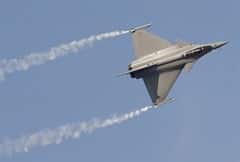
NATO has struck in Iraq. Or, more precisely, two French Rafale warplanes bombed a storage depot in northern Iraq believed to be used by ISIS.
Washington cheered the French attack as the first wave of NATO military operations against the new enemy du jour, ISIS or the Islamic State. French president Francois Hollande, whose abysmal popularity ratings are now lower than Robespierre’s, butcher of the French Revolution, was elated by his show of machismo even if French voters were not.
What the French were really doing, of course, was show-casing their new Rafale fighter. There’s nothing like bombing Arabs to sell military hardware, as Israel has long shown.
Paris has been desperately trying to sell the Rafale, which is a very capable aircraft, to the Gulf Emirates, Saudi Arabia and India. Delhi signed an order for 126 Rafales in 2012 but has yet to implement it.
India knows France is desperate to sell Rafales and has been torturing the French with endless bureaucratic and contract delays while it tries to haggle down the price and improve co-production terms.
Two Rafales hardly mean full-scale NATO intervention in Iraq. Washington has been pressing NATO for decades to act as its gendarme in the Mideast. However, Europeans have been very reluctant to wade into the swamp of Mideast affairs or act as Washington’s native troops the way the Indian Army served the military needs of the British Empire. As the late Bavarian leader Franz Josef Strauss pithily put it, “we refuse to be foot soldiers for the American atomic knights.”
A notable exception was the French-led overthrow of Muammar Khadaffi in Libya. The always intemperate Libyan leader claimed in a 2011 interview that he helped secretly finance the election campaign of French conservative leader Nicholas Sarkozy, who just announced that he will run again for president in 2017.
France, backed by the Obama administration, managed to drag a few other reluctant European nations into the attack on Libya. French and British special forces led the anti-Khadaffi uprising. Khadaffi’s convoy was bombed by French warplanes (probably Rafales); the Libyan leader was then captured by a mob led by French intelligence agents and murdered.
If NATO and Europe thought it was getting a bonanza of Libyan high grade oil, it was very wrong. What it got was chaos in Libya, jihadist uprisings in Mali and Nigeria, and waves of boatpeople heading for Italy.
Undaunted by this awful mess, the US is demanding that NATO take a lead role in fighting the Iraq-Syrian ISIS. But the amateur lady strategists in the White House also managed to get themselves in a frightening confrontation with Russia over fragmenting Ukraine.
NATO found itself facing a possible war in East Europe for which it was wholly unprepared. The threat of a nuclear clash suddenly became very real as NATO blundered ever deeper into the Ukrainian crisis.
This left Noble Peace Prize winner Barack Obama facing major confrontations in Eastern Europe and Mesopotamia – while trying to “pivot” to Asia. While the White House may be hoping that the wily Vladimir Putin will again rescue it from its own folly, as he did over Obama’s threats to attack Syria in 2013, it seems likely that the US will be quickly drawn ever deeper into the mess in the Levant and Mesopotamia.
Meanwhile, US Secretary of State John Kerry just visited Cairo where he sought to enlist Egypt’ military junta to fight ISIS and possibly take over Libya, a notion that dates from the days of the late Anwar Sadat.
As for NATO, many Europeans wonder why the North Atlantic Treaty Organization still exists, given that it was created at counter the very real threat in the early Cold War years of a Soviet invasion of western Europe.
NATO, says top American strategist Zbig Brzezinski, is the key to American domination of Europe. Washington pays 75 percent of NATO’s bills. NATO has allowed Europe to skimp on military spending. No wonder Europe is reluctant to get into new Mideast war.
The alliance has grown so feeble that the best President Obama could come up with to counter the alleged Russian threat was a feeble 4,000-man “spearhead” unit, backed by the equally feeble 8-10,000 US military personnel scattered across Europe. The rest of the once mighty 400,000 US garrison in Europe has gone home or is deployed on imperial missions. Russia is not much better off militarily.
There are even voices in Europe calling for abandoning NATO and forming a united European Union military, an idea strongly opposed by Washington. Russia has scared many of these NATO critics back into the arms of the alliance. But once the Ukraine crisis abates, expect renewed calls for Europe to shake off its dependency on the US and embark on an independent course.
Reprinted with author’s permission from his blog.

